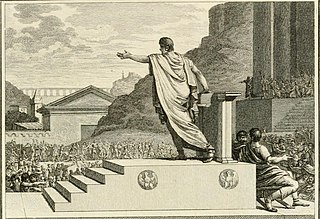Related Research Articles
The gens Papiria was a patrician family at ancient Rome. According to tradition, the Papirii had already achieved prominence in the time of the kings, and the first Rex Sacrorum and Pontifex Maximus of the Republic were members of this gens. Lucius Papirius Mugillanus was the first of the Papirii to obtain the consulship in 444 BC. The patrician members of the family regularly occupied the highest offices of the Roman state down to the time of the Punic Wars. Their most famous member was Lucius Papirius Cursor, five times consul between 326 and 313 BC, who earned three triumphs during the Samnite Wars. Most of the Papirii who held office under the later Republic belonged to various plebeian branches of the family. Although the most illustrious Papirii flourished in the time of the Republic, a number of the family continued to hold high office during the first two centuries of the Empire.

Lucius Papirius Cursor was a celebrated politician and general of the early Roman Republic, who was five times consul, three times magister equitum, and twice dictator. He was the most important Roman commander during the Second Samnite War, during which he received three triumphs.

The gens Sempronia was one of the most ancient and noble houses of ancient Rome. Although the oldest branch of this gens was patrician, with Aulus Sempronius Atratinus obtaining the consulship in 497 BC, the thirteenth year of the Republic, but from the time of the Samnite Wars onward, most if not all of the Sempronii appearing in history were plebeians. Although the Sempronii were illustrious under the Republic, few of them attained any importance or notice in imperial times.
The gens Servilia was a patrician family at ancient Rome. The gens was celebrated during the early ages of the Republic, and the names of few gentes appear more frequently at this period in the consular Fasti. It continued to produce men of influence in the state down to the latest times of the Republic, and even in the imperial period. The first member of the gens who obtained the consulship was Publius Servilius Priscus Structus in 495 BC, and the last of the name who appears in the consular Fasti is Quintus Servilius Silanus, in AD 189, thus occupying a prominent position in the Roman state for nearly seven hundred years.
Gaius Furius Pacilus Fusus was a Roman statesman of the early Republic. He was a descendant of the ancient patrician house of the Furii, which filled the highest offices of the Roman state from the early decades of the Republic to the first century AD. He was probably closely related to Quintus Furius Pacilus Fusus, whom Livy mentions as Pontifex Maximus in 449 BC, and was likely the father of Gaius Furius Pacilus, consul in 412 BC.
Lucius Julius Iullus was a member of the ancient patrician gens Julia. He was one of the consular tribunes of 438 BC, magister equitum in 431, and consul in 430 BC.
Gaius Julius Iullus was a Roman statesman and member of the ancient patrician gens Julia. He was consular tribune in 408 and 405 BC, and censor in 393.
Lucius Sergius Fidenas was a Roman politician during the 5th century BC, and was elected consul in 437 and 429 BC. In 433, 424, and 418 BC he was military tribune with consular power.
Lucius Papirius Mugilanus was a Roman politician and the suffect consul in 444 BC along with Lucius Sempronius Atratinus. The consulship was mostly peaceful, including renewing a treaty with Ardea.
Servius Cornelius Maluginensis was a politician and general of the Roman Republic. He was elected consular tribune seven times in 386, 384, 382, 380, 376, 370, and 368 BC. Despite having one of the most successful careers of the Republic, Servius' life is seldom known.
Lucius Sempronius Atratinus was a Roman politician and the suffect consul in 444 BC along with Lucius Papirius Mugillanus. The consulship was mostly peaceful, including renewing treaty with Ardea.
Manius Papirius Crassus was consul of the Roman Republic in 441 BC.
Lucius Quinctius Cincinnatus was a consular tribune of the Roman republic in 438, 425, 420 BC and possibly consul in 428 BC.
Lucius Papirius Crassus was a consul of the Roman republic in 436 BC and possibly a censor in 430 BC.
Aulus Sempronius Atratinus was a consular tribune of the Roman Republic in 425, 420, 416 BC and possibly consul in 428 BC.
Quintus Fabius Vibulanus was a consul of the Roman Republic in 423 BC and a consular tribune in 416 and 414 BC.
Spurius Nautius Rutilus was a consul of the Roman Republic in 411 and a consular tribune in 419, 416 and 404 BC.
Marcus Papirius Mugillanus was a consular tribune in 418 and 416 BC, and perhaps consul of the Roman Republic in 411.
Appius Claudius Crassus was a consular tribune of the Roman Republic in 403 BC.
Gaius Poetelius Libo Visolus was a Roman politician and general who lived in the mid-fourth century BC and served multiple times as consul.
References
- ↑ Broughton, Magistrates of the Roman Republic, 1951, vol i, pp.66, 69, 72
- ↑ Broughton, vol i
- 1 2 Chronograph of 354
- ↑ Livy, Ab Urbe Condita , iv. 30.12
- ↑ Diodorus Siculus, Bibliotheca historica , xii, 78.1
- ↑ Broughton, vol i, pp.66
- ↑ Livy, iv, 42.2
- ↑ Valerius Maximus, Factorum ac dictorum memorabilium libri IX, vi, 5.2
- ↑ Broughton, vol i, pp.69
- ↑ Livy, iv, 43.9
- ↑ Broughton, vol i, pp.70-71
- ↑ Fasti Capitolini
- ↑ A. Degrassi, Fasti Consulares et Triumphales, in Inscriptiones Italiae, XIIII, 1. Rome (1947), pp. 26f, 97, 376f
- ↑ Broughton, vol i, pp.72
- ↑ F. Münzer. in A. Pauly, G. Wissowa, and W. Kroll (eds.), Real-Encyclopädie d. klassischen Altertumswissenschaft, 1894-, No. 37
- ↑ Degrassi, pp. 96, 374f
- ↑ Broughton, vol i, pp.66 (427 BC:note 1)